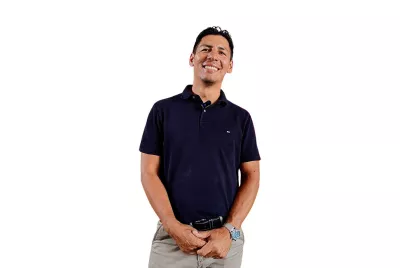‘We Won’t Let Anything Happen to You’

Midwinter temperatures in Houston, Texas, typically hover around 56 degrees. But during the week that began on Valentine’s Day 2021, the city—like the entire state of Texas—was suddenly slammed with a deep-freeze disaster of historic proportions.
“It was the worst weather-related disaster I’ve seen in my 21 years at Covenant House Texas,” recalls Victor Hay, director of our safe haven program in Houston. Temperatures crashed by more than 35 degrees, and snow, sleet, and freezing rain ravaged the area. Roads became impassable. Covenant House Texas (CHTX) was without lights and water for days.
Even after the utilities came back on, the emergency persisted. “There was a boiled-water alert,” says Felicia Broussard, CHTX director of development. “We couldn’t shower, drink, or brush our teeth with the tap water. Because of the COVID pandemic, sanitation was a real necessity, but you couldn’t wash your hands with the tap water.” She put out a call to community partners, and within hours, had received hundreds of gallons of bottled water.
With up to 36 young people in residence at the safe haven, Victor’s role became all about keeping the youth safe, fed, and as stress-free as possible. “We had meals prepared that didn’t need a microwave or oven. We told the kids there was no need to struggle. We had game nights, a talent show by flashlight—Cov at the Improv!—and friendly conversations. And they did well. They understood we were in a crisis, and they volunteered to help out.”
Everything went smoothly because Covenant House Texas was prepared.
Preparing for severe weather events is not confined to any one season anywhere across our Covenant House federation. Our houses may be—and have been—impacted by everything from floods and fires to hurricanes, earthquakes, tornadoes, and freezing temperatures and storms.
In Houston, harsh and damaging weather is a regular occurrence. “The Houston area is known for flooding, tornadoes, and hurricanes,” says Victor.
“Extreme heat is a great risk, too,” Felicia adds, “and it comes every year in late summer, and lasts for a prolonged time. It’s just as hot at night as it is during the day. We let people know we have air conditioning and that they can come here if they need to, because the extreme heat is life-threatening.”
In short, says Victor, “We know we’re going to have a disaster, we just don’t know when, so we have to always be prepared.”
CHTX is ready for anything, with a “disaster closet” filled with supplies that staff maintain year-round. They ensure there’s always about a two-week supply of basics. The closet contains items such as batteries, cell phone chargers, flashlights, dry goods, bath and laundry soap, first aid kits, baby food, dry and bottled food, disinfectant wipes, tissues, N95 masks, and more.
“We check the expiration dates and the amounts of each item in the closet on a regular basis. Then, when there’s a threat of a hurricane, for instance, we do an inventory, and we make sure staff have access to the closet no matter who is on-site.”
When a disaster looms, CHTX staff organize themselves, too. “We have a ride-out team made up of staff who come and stay on-site for the duration of the disaster,” Victor says. There are enough staff members on the team to cover three shifts a day.
Staff also ensure that each youth is supplied with two bath towels and a face towel and that cash is set aside to cover the costs of washing clothes and for additional food, water, and gasoline in the event of an evacuation.
If it becomes necessary to evacuate because of a storm or other event, the ride-out team will travel with the young people to a safe destination, and another team will stay behind to evaluate when it’s safe to return, once any necessary repairs have been made. Covenant House New Orleans staff adopted this same practice last year, when Hurricane Ida forced youth and a ride-out team to neighboring Texas, where they were sheltered at CHTX.
Maintaining the disaster closet, organizing ride-out and stay-behind teams, performing quarterly maintenance on the CHTX generator, and ensuring accompaniment before, during, and after a severe weather event are all meant to ensure the safety and well-being of our young people.
“Homelessness was their issue, and they went through it alone. A disaster is an issue we all have, and we go through it together. We create a family environment and all shiver together when it’s cold and threatening,” Victor says. “And we assure the young people that we won’t let anything happen to them. We’re ready, and no matter what happens during this storm, we won’t let anything happen to you.”
You might also like...
All storiesShelter Is Only the Beginning
From crisis to care: Find out what it's like when a young person enters our doors.


